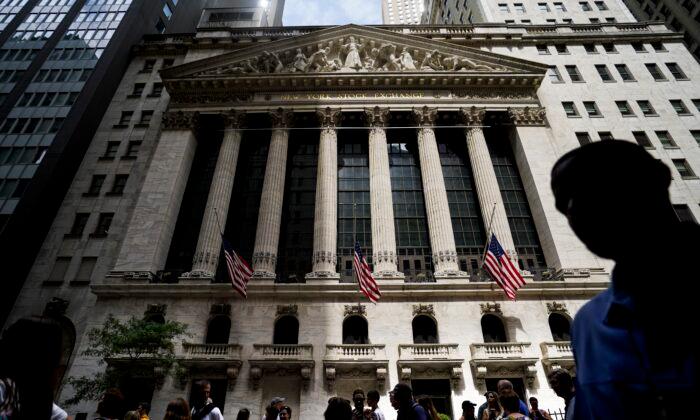Stocks closed broadly higher again Thursday as investors grew more optimistic that a slowing U.S. economy means the Federal Reserve can temper its aggressive interest rate hikes aimed at taming inflation.
The S&P 500 rose 1.2 percent as more than 80 percent of the stocks in the benchmark index closed higher. The Dow Jones Industrial Average gained 1 percent and the Nasdaq rose 1.1 percent. Smaller company stocks edged out the broader market, lifting the Russell 2000 by 1.3 percent.
The Commerce Department reported that the economy contracted at a 0.9 percent annual pace last quarter. The decline in the gross domestic product—the broadest gauge of the economy—followed a 1.6 percent annual drop from January through March. Consecutive quarters of falling GDP are an informal, though not definitive, indicator of a recession.
The GDP report signaled weakness across the economy. Consumer spending slowed as Americans bought fewer goods. Business investment fell. Inventories tumbled as businesses slowed their restocking of shelves, shedding 2 percentage points from GDP.
The Federal Reserve has made slowing the U.S. economy to tame the highest inflation in 40 years its goal by raising interest rates, most recently on Wednesday. The latest GDP report, along with other recent weak economic data, could be giving some investors confidence that the central bank will be able to ease up on the size of any further rate hikes in the months to come, analysts said.
“Sometimes bad news is good news,” said Megan Horneman, chief investment officer at Verdence Capital Advisors. “The Fed may not have to be as aggressive as once thought. That’s what investors are looking at.”
In a research note Thursday, Jonathan Golub, chief U.S. equity strategist at Credit Suisse Securities, said “Whether or not we are in a recession will be debated by academics in the months ahead. However, today’s report unequivocally reflects a substantial weakening in economic activity, and raises the likelihood of a dovish pivot by the Fed.”
Traders now see a 74 percent chance that the Fed will raise its key rate by a half-point at its next policy meeting in September, and only a 26 percent chance of another 0.75-point increase, according to CME Group.
The central bank raised its key short-term interest rate by 0.75 percentage points on Wednesday, lifting it to the highest level since 2018. The move sparked a broad market rally led by technology stocks that helped give the Nasdaq its biggest gain in over two years. The major indexes are now all on pace for a weekly gain, extending Wall Street’s strong July rally.
On Thursday, the S&P 500 rose 48.82 points to 4,072.43, while the Dow added 332.04 points to close at 32,529.63. The Nasdaq gained 130.17 points to 12,162.59. The Russell 2000 rose 24.69 points to 1,873.03.
Technology stocks and retailers, restaurant chains and other companies that rely on direct consumer spending helped lift the S&P 500 Thursday. Microsoft rose 2.9 percent, Target gained 3.1 percent and McDonald’s added 1.8 percent higher.
Communication services stocks were the only laggards. Meta Platforms fell 5.2 percent after the social media giant said its revenue fell last quarter for the first time ever, dragged down by a drop in ad spending.
In a busy week of corporate earnings reports investors have focused on what companies are saying about inflation and the impact rising interest rates are having on their business and customers.
Markets were spooked Monday after retail giant Walmart warned that its profits are being hurt by rising prices for food and gas, which are forcing shoppers to cut back on more profitable discretionary items such as clothing.
Stanley Black & Decker slumped 16.1 percent Thursday after the tool maker’s second-quarter results fell short of Wall Street’s estimates. The company noted that demand significantly slowed in May and June.
Oshkosh fell 6.2 percent after the Wisconsin-based maker of postal trucks and military vehicles reported weaker-than-expected quarterly results and lowered its 2022 profit guidance, citing lingering supply chain disruptions and inflation.
Apple’s profit and revenue fell in its April-June quarter, but the results still beat analysts’ forecasts. The iPhone maker’s shares rose 0.4 percent, but added 3.9 percent in after-hours trading following the release of its earnings report.
Amazon jumped more than 12 percent in after-hours trading. It reported its second-consecutive quarterly loss but its revenue topped Wall Street’s expectations. The stock closed 1.1 percent higher during regular trading.
Meanwhile, Spirit Airlines shares rose 5.6 percent after JetBlue said it agreed to buy the budget airline for $3.8 billion to create the nation’s fifth largest airline. The agreement, which still requires regulator and shareholder approval, comes a day after Spirit’s attempt to merge with Frontier Airlines fell apart. Frontier Airlines vaulted 20.5 percent.
Bond yields were broadly lower. The two-year Treasury yield, which tends to move with expectations for the Fed, fell to 2.87 percent from 2.98 percent late Wednesday. The 10-year yield, which influences mortgage rates, fell to 2.68 percent from 2.74 percent.





